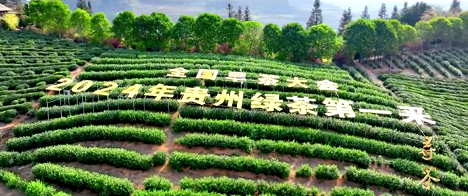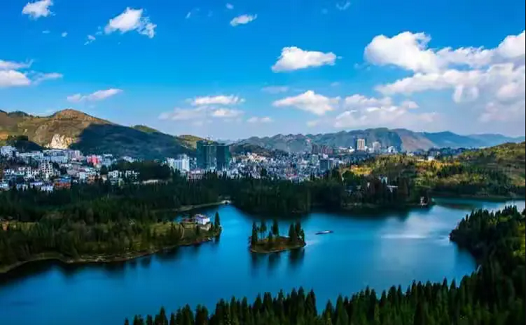- Profile Jurisdictions GOV DEPARTMENTS Cultures Travelling Educate
-
Puan County is located in the northern part of Qianxinan Buyei and Miao Autonomous Prefecture, Guizhou Province. It borders Qinglong to the east, Xingren and Xingyi to the south, Panzhou to the west, and Shuicheng and Liuzhi to the north. With a total land area of 1,453 square kilometers, it administers 4 subdistricts, 8 towns, and 2 townships, with a population of 359,000. The population is predominantly Han Chinese, with 29 ethnic minorities including Buyi, Miao, Yi, Hui, and Li also residing here, accounting for 30% of the total population.

The place name carries profound significance. In the first year of the Jingyan era of the Southern Song Dynasty, corresponding to the 13th year of the Zhiyuan era of the Yuan Dynasty (1276), to celebrate the end of warfare and the unification of Yunnan and Guizhou, the Yuan imperial court issued an edict renaming the Yushiman Hu Fu to the Puan Road General Administration Office. This name signified “universal peace and celebration,” implying “peace and prosperity for all living beings under heaven.”
Its history is long and enduring. Historically, it belonged to the Yelang Kingdom before undergoing successive administrative transformations: Loujiang County, Bengu County, Wuman, Awaige, Zangzhou, Baoman, Panshui County, Yushibu, Yushimanhu Prefecture, Puan Road General Administration Office, Puan Prefecture, Pusan Prefecture, Puan Pacifying Office, Puan Garrison, Puan Military-Civil Command Office, Puan Prefecture, and Annan Garrison. In the 18th year of the Shunzhi reign of the Qing Dynasty (1661), Puan County was established by combining the military camps of Manaiying, Louxiaoying, and Shuchangying from Puan Prefecture with the Xinxing and Xincheng administrative posts from Annan Garrison.

Its natural endowment is uniquely advantageous. Situated in the transitional zone of the Yunnan-Guizhou Plateau, it forms the watershed between the northern and southern basins of the Pan River. It features a typical humid subtropical monsoon climate with mild winters and cool summers. At an average elevation of 1,400 meters, it receives 1,400 mm of annual rainfall and maintains an average annual temperature of 14°C. With a frost-free period of approximately 290 days and a forest coverage rate of 55.31%, it is an ideal destination for escaping the cold and summer heat. It is home to nationally protected species such as the black-leafed mon key and black-necked crane, and hosts the nationally protected plant cycad.
The region boasts abundant and diverse resources. Its deposits include 28 types of minerals such as coal, gold, iron, silicon, lead, zinc, phosphate, gypsum, and marble. Coal reserves are estimated at 17.2 billion tons, with 5.4 billion tons accessible within 600 meters depth—ranking first in Qianxinan Prefecture and sixth in Guizhou Province. The theoretical hydropower potential is 340,000 kilowatts, with abundant resources for thermal power, wind power, and photovoltaic energy. In 1980, the world's only known fossil of a four-ball tea seed, dating back 1.64 million years, was discovered in Yuntou Mountain at the junction of Pu'an and Qinglong counties. The region is home to over 20,000 wild ancient tea trees with four-ball seeds—the largest and most concentrated population in China, unique to the world and exclusive to Guizhou. Among these, more than 3,000 trees are over 1,000 years old, earning them the title of “living fossils you can drink.” Currently, the county's tea gardens cover 183,000 mu (approximately 12,000 hectares), producing pollution-free tea rich in trace elements like selenium and zinc. Spring tea from the core production areas hits the market about 20 days earlier than in other parts of the country. On January 1, 2022, Puan County was designated the permanent first-picking site for “Guizhou Green Tea” by the Provincial Rural Industrial Revolution Tea Development Leading Group.
Transportation is well-connected. Situated midway between Guiyang and Kunming, the county is traversed by major arteries including National Highway 320, the Shanghai-Kunming Expressway, the Shanghai-Kunming High-Speed Railway, Qingxiong Expressway, and Naqing Expressway. Provincial and county roads crisscross the terrain, while township and village roads wind through the landscape. High-speed rail travel to Guiyang or Kunming takes just one hour each, and the drive to Wanfenglin Airport is only one hour.
Distinguished by its cultural heritage. The county boasts historical sites like the Tea-Horse Road (a national key cultural relic protection unit of the seventh batch) and the Nanyang Ruins at Qingshan Tonggu Mountain. It has earned accolades including “Top Ten Charming Tea Towns in China,” “Hometown of Ancient Tea Trees in China,” “Hometown of Chinese Tea Culture,” “National Key Tea-Producing County,” and “National Geographical Indication Product for Agricultural Products.” “Puan Hong” tea has been honored as a “Famous Tea of Chinese Culture.” Longyin Town has been named “China's Premier Miao Ethnic Town.” Qingshan Community is listed in the National Register of Traditional Villages and the National Register of Civilized Villages and Towns, while Shili Village, Lianmeng Village, Xizhai Village, Hama Village, and Yinlu Village are included in the National Register of Civilized Villages and Towns. The area boasts national intangible cultural heritage such as the Rade Degen (Miao Lusheng Dance), provincial intangible cultural heritage including the Doudanda Yin (Bouyei Small Percussion Music), Yi Hi Ma Dance, Longxi Stone Inkstone, Miao Ethnic Costumes, and Miao Martial Arts Opera.
contact details
Tel:00-86-0859-7232127
Address:No. 12 West Street, South Lake Community, South Lake Street, Puan County
Working hours: Weekdays: 08:30 a.m. - 12:00 p.m. 14:30 p.m. - 18:00 p.m.
